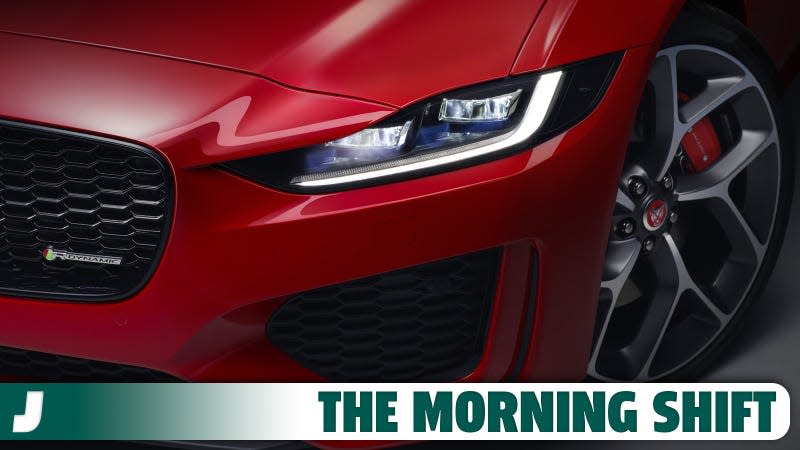Jaguar Thinks Its Mistake Was Trying To Please Everyone

Good morning! It’s Tuesday, July 25, 2023 and this is The Morning Shift, your daily roundup of the top automotive headlines from around the world, in one place. Here are the important stories you need to know.
1st Gear: The Brand With ‘No Equity Whatsoever’
Those are not our words, but the the words of Jaguar’s Chief Creative Officer Gerry McGovern, who recently joined the rest of Jaguar Land Rover to present the the British automaker’s plans for the future to investors in England. It just so happens that the United States is key to this strategy, because the U.S. has plenty of millionaires. Again, not our words. Courtesy Automotive News Europe:
Read more
Jaguar’s past U.S. success is now “lost within Ford Motor Company data,” said [Adrian] Mardell, who was confirmed as JLR CEO on July 20 after holding the position on an interim basis.
Mardell joined JLR in 1990, the year after Ford bought the company from British Leyland. Back then, Jaguar was targeting a much richer customer. Its XJ sedan started at $54,750 in the U.S., equivalent to around $100,000 today, while the XK coupe cost from $69,900.
The brand hopes to be similarly successful with its new, more luxurious range. “There are 20 million millionaires in the U.S. alone,” Mardell said. “So, a lower volume, higher price positioning is absolutely the right position for Jaguar today.”
It’s unfortunate, though not terribly surprising, that Jaguar has seemingly lost a chunk of its history to Ford’s annals. Either way, the brand will draw upon its strategy then to determine how to proceed in North America. It’ll also try to upset people, because that’s always a compelling strategy when potential buyers aren’t paying attention to you:
Trying to appeal as many premium buyers as possible pushed the brand into “mediocrity,” JLR Chief Creative Officer Gerry McGovern said at the same investor event, held at JLR’s HQ in Gaydon, central England.
McGovern is leading the design of the first new model of Jaguar’s new era, a full-electric four-door GT. The GT will be the first of three all-new electric Jaguars. It will be unveiled this year and will go on sale next year, starting at 100,000 pounds ($129,000) in the U.K.
The design of the new models will split opinion, McGovern said.
“What we will not worry about is being loved by everybody, because that is the kiss of death,” he said. “That is what put Jaguar in the situation it is in today, which is with no equity whatsoever.”
McGovern’s perspective sounds not terribly dissimilar from that of BMW’s designers over the past few years, which basically amounts to designing cars to generate discord, rather than approval. This was Jaguar’s faux pas, the way the chief designer sees it, and not that its offerings have been routinely middle of the pack or obviously aged over the past decade.
Here’s our friend Andrew Collins’ review of a Jaguar E-Pace from five years ago where he recommends a Mazda CX-3 instead. Here’s our friend Kristen Lee’s review of a Jaguar F-Type SVR from 2020, which she found to be good but definitely not worth $150,000. Perhaps these products failed to reach buyers because they were too conventionally pretty or everything to everyone. (I’m less inclined to believe the latter for the six-figure F-Type.) Or perhaps they failed because they were merely fine, rather than astounding, and Jaguar didn’t do marketing at the time. A poor reputation for quality probably didn’t help things either. Jaguar need only look within the family to understand making enemies isn’t necessary to get noticed. But that’s the playbook it’s chosen to follow.
2nd Gear: Even The Big Bolt Recall Couldn’t Ruin GM’s Second Quarter
General Motors’ second quarter figures are in, and they’re looking good, with a 52 percent rise in income year-over-year during the period. The result has emboldened the company to plan to slash $3 billion in fixed costs, rather than its earlier target of $2 billion, by 2025. And it now expects to end 2023 with an extra $1 billion in adjusted earnings, for a total of $12 to $14 billion, per Automotive News. Unless a strike throws a wrench into things, anyway.
“We’re building momentum thanks to incredible customer response to our new trucks and SUVs, and strong execution of our business plan by the GM team, our dealers and our suppliers,” GM CEO Mary Barra said in a letter to shareholders.
GM’s updated guidance assumes the company will reach a new contract with the UAW later this year without a work stoppage, which could prove difficult given the union’s heated rhetoric. CFO Paul Jacobson, speaking to media, declined to say how a strike this fall might impact the automaker.
Jacobson also said the company’s more aggressive cost-cutting efforts would not include any additional planned staff reductions. About 5,000 salaried employees chose to take a buyout early this year as part of the automaker’s previous $2 billion reduction target.
Demand was particularly strong in North America, according to CEO Mary Barra. GM is working to build double the number of EVs in the second half of 2023 versus the first, where manufacturing for the Cadillac Lyriq and GMC Hummer EV was constrained. Speaking of EVs, GM continues to take a bath on that massive Bolt battery recall, which cost the company $792 million in the quarter alone. To date, it reports that it’s fixed 80 percent of affected vehicles.
3rd Gear: Hyundai’s Latest Effort To Fix Theft-Prone Cars
As of June, Hyundai reported that only 9 percent of eligible vehicles had its anti-theft software update installed, while for Kia that figure rested at 11 percent. That’s simply not good enough. To address it, the Korean automaker has decided to take over a Washington, D.C. stadium that hasn’t been in regular use in 15 years and will soon be destroyed for a sort of mass-update party. From Auto News:

 Yahoo Autos
Yahoo Autos 